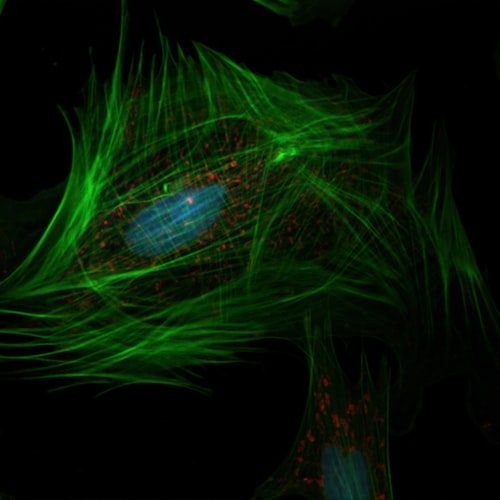Targeting Defects in Cell’s ‘Skeleton’ May Restore Cellular Function in SMA, Early Study Shows

Photo by National Cancer Institute on Unsplash -cytoskeleton
Low levels of the survival motor neuron (SMN) protein — the major root cause of spinal muscular atrophy (SMA) — may lead to defects in the “skeleton” of cells, which can affect cell growth and function, an early study in yeast suggests.
In particular, one of the defects described in the study is the excessive formation of actin filaments. Actin is one of the major components of the cell’s cytoskeleton — a network of fibers that organizes a cell’s components, maintains cell shape, and is responsible for the movement of components inside cells.
Targeting actin dynamics may be a potential strategy for restoring normal cellular function in SMA cells and may also point to common disease mechanisms shared by SMA and amyotrophic lateral sclerosis (ALS), another motor neuron disease.
The study, “Splicing Defects of the Profilin Gene Alter Actin Dynamics in an S. pombe SMN Mutant,” was published in the journal iScience.
SMA is a genetic disorder characterized by progressive muscle weakness caused by loss of specialized nerve cells called motor neurons, which control voluntary muscle movements and are located in the brain and spinal cord.
In most cases, the disease is caused by mutations in the SMN1 gene, which results in the deficiency of SMN protein. It remains unclear how the lack of a functional SMN protein results in neurodegeneration, or the progressive damage and death of motor neurons.
To better understand the mechanisms leading to SMA, researchers investigated the cellular defects associated with SMN deficiency in a yeast model called Schizosaccharomyces pombe (S. pombe), also known as fission yeast.
Yeast models are important tools to study biological pathways and to pinpoint mechanisms underlying essential cellular processes. They have helped to unravel many gene functions and pathways involved in human diseases, including neurodegenerative diseases.
In yeast, SMN deficiency alters splicing, a process by which genetic blueprints called messenger RNA (mRNA) are processed to guide the production of proteins.
As a result of low SMN protein, yeast cells display strong splicing defects, specifically in a gene providing instructions for producing profilin, a small protein that binds to and regulates the formation of actin into filaments inside cells, or actin polymerization.
Splicing defects triggered by SMN deficiency lowered profilin levels, which in turn led to an excessive formation of actin filaments resulting in impairments in endocytosis (a process by which substances are brought into the cell), and delaying cellular division and growth.
Defects in actin dynamics and endocytosis have also been reported in other SMA models. These findings could provide “a framework for understanding how actin dynamics might become altered in SMN-deficient cells,” the researchers said.
They reasoned that restoring normal actin dynamics might rescue SMA models from cellular defects.
Eliminating the ACP1 gene — which provides instructions for producing a protein that binds and locks the fast-growing ends of actin filaments — had a protective effect against SMN deficiency, safeguarding yeast cells from the cytoskeleton defects and the associated delays in endocytosis and cell division.
“Given that cytoskeletal defects in the brain and spinal cord tissues emerge as one of the most important causes of motor neuron vulnerability, it is tempting to speculate that SMA could also be caused by splicing alterations in genes playing a role in actin dynamics,” the researchers said.
The formation of axons and correct function of the synapse are dependent on crosstalks between actin filaments and other cytoskeleton members.
Axons are the long projections of neurons that conduct electrical impulses away from the neuron’s body, while the synapse is the junction between two nerve cells allowing them to communicate.
Future work will be necessary to define precisely the splicing pattern of many attractive candidates including genes coding for the various actin-binding partners, many isoforms [protein variants] being implicated in the assembly of different actin cellular structures,” they said.







